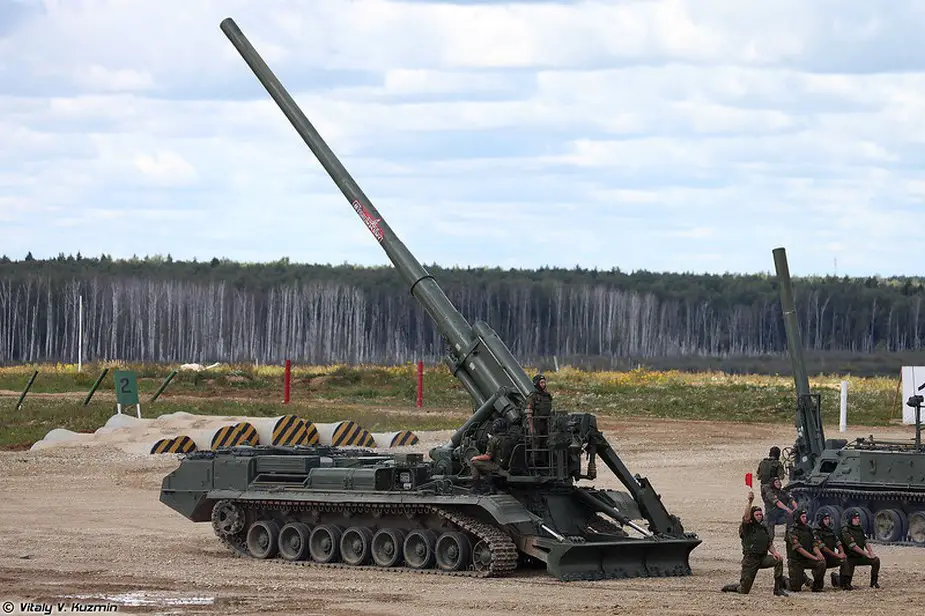In early 2016, several military districts used the 2S7M Malka 203 mm self-propelled howitzers (SPHs) after a long period of storage. The crews fired high-explosive fragmentation shells at a distance of some 25 km, using HE-Frag rounds.

2S7M Malka 203mm self-propelled howitzer at Armya 2018 (Picture source: Vitaly Kuzmin)
The counter-terrorism operation in Syria has put on the agenda the use of heavy artillery systems armed with 152 mm - 210 mm howitzers. It became clear that heavy self*propelled howitzers and mortars were required to destroy fortifications and protected engineering installations. Thus, the issue of activation of heavy artillery units manned only by contract soldiers and armed with the 2S7M Malka SPHs and 2S4 Tyulpan heavy mortars with guided artillery projectiles (GAPs) still remains urgent. The use of heavy artillery systems allows turning the tide of combat in favor of the offending side.
JSC Scientific and Research Engineering Institute (NIII, a subsidiary of Rostec`s Tecmash concern) upgrades the existing and advanced explosive ordnance device suits with the use of combat experience gained in Syria. The Russian engineers were using the items of equipment developed by NIII during mine clearance missions. The enterprise is planning to upgrade those EOD suits, using the gathered experience. NIII has received upgraded manufacturing capacities that have been built under a federal targeted program aimed at the development of the defense industry through 2020.
The P-7 parachute systems developed by Rostec`s Tekhnodinamika holding have confirmed their strong performance during the counter-terrorism operation in Syria. The P-7 allows airdropping of more than 30 types of cargoes with a total weight of 9,300 kg. The system`s maximum airdropping altitude reaches 2,500 meters above sea level. The P-7 integrates a platform and several multi-dome parachutes. It should be mentioned that the Scientific-and-Research Institute of Parachute-Building, a subsidiary of Tekhnodinamika, is planning to develop a disposable platform for cargo airdropping. The VDV troops are considering four projects of cargo platforms that have lifting capacities varying between 500 kg and 1,500 kg.
The Russian MoD and the Tula-based JSC Splav, a subsidiary of Rostec`s Tecmash concern, are finishing the trials of a new long-range rocket for the TOS-1A Solntsepyok rocket launcher. The rocket can burn out enemy`s engineering installations, weapon systems, and manpower in an area of several thousand sq km at a distance of 10 km. Compared to the existing weapons, the new item features a larger firing range (the previously developed M0.1.01.04M rocket for the Solntsepyok can be launched at a distance of some 5-6 km) and more effective thermobaric warhead. The rocket diffuses a cloud of fuel and then explodes it, creating an effective air blast that destroys hostile assets. The weapon also features a new explosive fuel and explosives that ensure such high combat performance. The TOS-1A rocket launchers were spotted in Syria in Autumn 2015. Due to their high power, the systems were used to engage the terrorists of ISIS that were located out of the historical center of Palmyra and populated areas in order to prevent civilian casualties.
The deliveries of the new engineering items of combat-tested equipment to the Russian troops started in 2017. The engineers will receive more EOD suits, robotic systems, and other sophisticated gear.
Russia has helped the Syrian military reactivate the combat capabilities of rocket and artillery units, said the Chief of Russia`s Missile Troops and Artillery Lieutenant General Mikhail Matveevskiy. The commanders of those units have been retrained in terms of modern combat requirements and features, and the capacities of these Syrian troops have increased in a substantial manner. In particular, the functioning of artillery reconnaissance has been restored.
It should be mentioned that the Smerch, Uragan, and Grad multiple launch rocket systems, Tochka/Tochka-U (NATO name: SS-21 Scarab-A/SS-21 Scarab-B) tactical ballistic missile systems, Msta-B and D-30 towed howitzers, and TOS-1A rocket launchers have shown robust performance during the operations in Syria. According to the Chairperson of Military-Scientific Committee - Deputy Chief of General Staff Lieutenant General Igor Makushev, the artillery systems have engaged 45% of targets.
© Copyright 2019 TASS / Army Recognition Group SPRL . All rights reserved. This material may not be published, broadcast, rewritten or redistributed.














